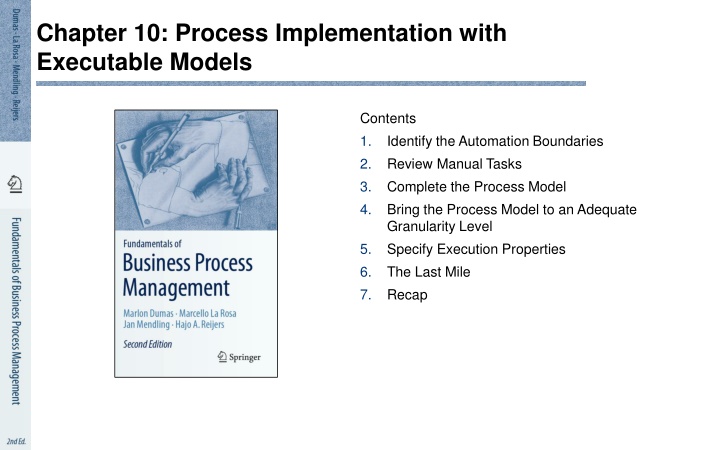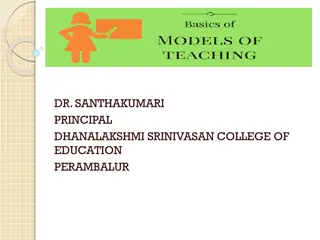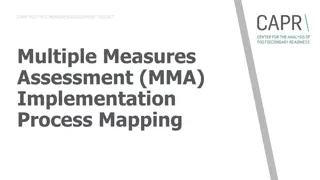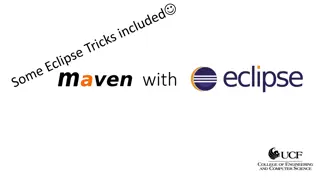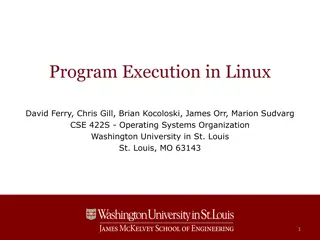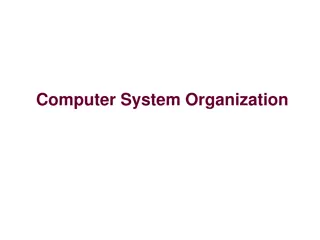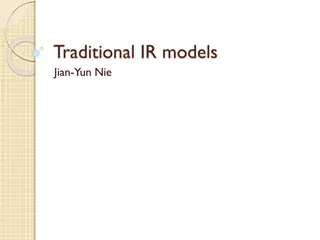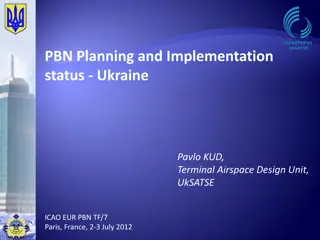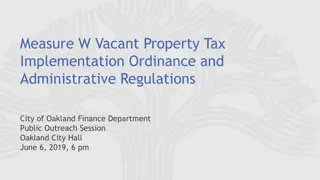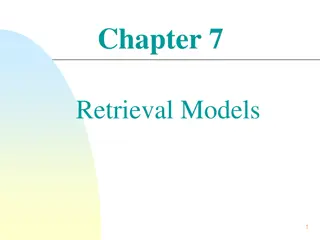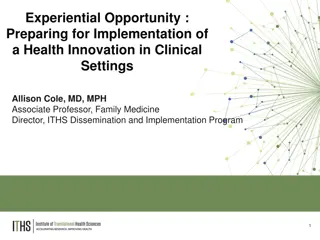Process Implementation with Executable Models
This chapter delves into the transformation of conceptual models into executable models for process-aware information systems. It outlines a systematic method involving steps such as identifying automation boundaries, reviewing manual tasks, completing the process model, achieving an adequate granularity level, and specifying execution properties. Standards like CMMN and DMN complement BPMN in this process.
Download Presentation

Please find below an Image/Link to download the presentation.
The content on the website is provided AS IS for your information and personal use only. It may not be sold, licensed, or shared on other websites without obtaining consent from the author.If you encounter any issues during the download, it is possible that the publisher has removed the file from their server.
You are allowed to download the files provided on this website for personal or commercial use, subject to the condition that they are used lawfully. All files are the property of their respective owners.
The content on the website is provided AS IS for your information and personal use only. It may not be sold, licensed, or shared on other websites without obtaining consent from the author.
E N D
Presentation Transcript
Chapter 10: Process Implementation with Executable Models Contents 1. Identify the Automation Boundaries 2. Review Manual Tasks 3. Complete the Process Model 4. Bring the Process Model to an Adequate Granularity Level 5. Specify Execution Properties 6. The Last Mile 7. Recap
Process Implementation in the BPM Lifecycle Management Processes Process identification Define Vision Develop Strategy Implement Strategy Manage Risk Examples for BPM lifecycle and process mining Core Processes Manage Customer Service Procure Materials Procure Products Market Products Deliver Products B 30h Support Processes 35h Process architecture 15h Manage Information Manage Personnel Manage Assets A E D 3m 10m 2h 5m 30m 10m 5m Process discovery C Conformance and performance insights As-is process model 15m 1.5h 10min Process monitoring Process analysis Insights on weaknesses and their impact Executable process model Process Process redesign implementation To-be process model
Chapter Overview This chapter deals with turning conceptual models into executable models Executable models can be used by a process-aware information system to coordinate a business process We propose a systematic method for carrying out this transformation, which consists of five steps: 1. Identify the automation boundaries, 2. Review manual tasks, 3. Complete the process model, 4. Bring the process model to an adequate level of granularity, and 5. Specify execution properties. By following this method a conceptual model incrementally becomes less abstract and more IT-oriented As part of this method, two standards complementary to BPMN are used: the Case Management Model and Notation (CMMN), and the Decision Model and Notation (DMN)
Chapter 10: Process Implementation with Executable Models Contents 1. Identify the Automation Boundaries 2. Review Manual Tasks 3. Complete the Process Model 4. Bring the Process Model to an Adequate Granularity Level 5. Specify Execution Properties 6. The Last Mile 7. Recap
Setting the boundaries Guiding principle: not all processes can be automated. Based on this principle, establish which parts of a process can be coordinated by the BPMS and which parts cannot Input: the conceptual model of the business process Three types of tasks are to be distinguished: 1. Automated: are performed by the BPMS itself or by an external service, 2. Manual: are performed by process participants without the aid of any software, 3. User: are performed by a participant with the assistance of the worklist handler of the BPMS or an external task list manager
Notation The distinction between automated, manual, and user tasks is captured in BPMN via specific markers on the top-left corner of the task box Manual tasks are marked with a hand, User tasks are marked with a user icon. Automated tasks are further classified into the following subtypes in BPMN: Script (script marker), if the task executes some code (the script) internally to the BPMS Service (gears marker), if the task is executed by an external application, which exposes its functionality via a service interface Business rule (table marker), if the task triggers a business rule to be executed by a rules engine external to the BPMS Send (filled envelope marker), if the task sends a message to an external service, Receive (empty envelope marker), if the task waits for a message from an external service
Exercise 10.1 Assume you have to automate the loan assessment process model of Solution 3.8 (page 110) for the loan provider. Start by classifying the tasks of this process into manual, automated, and user tasks. Then, represent them with appropriate task markers.
Chapter 10: Process Implementation with Executable Models Contents 1. Identify the Automation Boundaries 2. Review Manual Tasks 3. Complete the Process Model 4. Bring the Process Model to an Adequate Granularity Level 5. Specify Execution Properties 6. The Last Mile 7. Recap
Review manual tasks Goal: check whether the manual tasks can be linked with the BPMS Guiding principle: if the task cannot be seen by the BPMS, it does not exist Two ways of linking a manual task to a BPMS: 1. Implement as User Task 2. Implement as Automated Task Note: There are cases in which it is not convenient to link manual tasks to a BPMS.
Chapter 10: Process Implementation with Executable Models Contents 1. Identify the Automation Boundaries 2. Review Manual Tasks 3. Complete the Process Model 4. Bring the Process Model to an Adequate Granularity Level 5. Specify Execution Properties 6. The Last Mile 7. Recap
Complete the Process Model Main goal: Establish that the the process model is complete Two principles underlie this step: i) exceptions are the rule, and ii) no data implies no decisions and no task handoff (so, better include how data is used and produced) Puzzle, Match, Fit, Missing, Complete, Play, Task
Exceptions Often, conceptual process models neglect certain information because modelers deem it as irrelevant for the specific modeling purpose, they assume it is common knowledge, or they are simply not aware of it. Depending on the application scenario, it may be fine to neglect this information in a conceptual model; however, information that is not relevant in a conceptual model may be highly relevant for a process model to be executed In the majority of cases, a model must completed with the aspects concerning exceptions to make it executable
Data objects Purpose: All electronic data objects that are required as input and output by the tasks of our process need to be specified Rationale: Data objects are often assumed to exist in a conceptual model. In an executable model, where a software engine has to run the model, they need to made explicit. Each data object needed by the BPMS engine to pass control between tasks and to take decisions must be modeled.
Chapter 10: Process Implementation with Executable Models Contents 1. Identify the Automation Boundaries 2. Review Manual Tasks 3. Complete the Process Model 4. Bring the Process Model to an Adequate Granularity Level 5. Specify Execution Properties 6. The Last Mile 7. Recap
Granularity Tasks in a conceptual model may not be at the right level of granularity for implementation They may be either: too abstract, in which case we need to decompose them, or too detailed, in which case they should be aggregated https://upload.wikimedia.org/wikipedia/commons/thumb/8/80/Cobbles_Nash_Point.jpg/1920px-Cobbles_Nash_Point.jpg Guiding principle: A BPMS adds value if it coordinates handoffs of work between resources
Unordered tasks As a rule of thumb, a (sub-)process whose tasks are performed in an ad hoc manner, without any predictable order, is not suitable for automation via a BPMN- based BPMS. In this case, a case management system or an ad hoc workflow system is more appropriate. If the BPMS supports the Case Management Model and Notation (CMMN) language, this is not an issue
CMMN Defines which tasks have to be executed, although potentially restricted by certain conditions Describes what has to be achieved in a process instead of how to achieve it Can be used as a type of sub-process in a BPMN model, but also vice versa: tasks in a CMMN model can have BPMN sub-processes.
Chapter 10: Process Implementation with Executable Models Contents 1. Identify the Automation Boundaries 2. Review Manual Tasks 3. Complete the Process Model 4. Bring the Process Model to an Adequate Granularity Level 5. Specify Execution Properties 6. The Last Mile 7. Recap
Execution Properties To make the model fully executable, we need to specify in the last step how each model element is effectively implemented by the BPMS of choice The relevant Execution Properties are: Variables, messages, signals, errors, and their data types, Data mappings, Service details for service, send and receive tasks, and for message and signal events, Code snippets for script tasks, Participant assignment rules and user interface structure for user tasks, Task, event, and sequence flow expressions, and Other BPMS-specific properties.
DMN Sometimes, the conditions that allow a process instance to be routed towards one or another path in the model can be quite complex. OMG has developed the Decision Model and Notation (DMN) standard, which can be used for specifying business rules DMN provides three parts for the specification of business rules: 1. the Decision Requirements Graph (DRG), which describes how data is propagated between different decisions, 2. the Simple Expression Language (S-FEEL) to define how values are extracted from variables, and 3. Decision Tables (DMN tables)
Chapter 10: Process Implementation with Executable Models Contents 1. Identify the Automation Boundaries 2. Review Manual Tasks 3. Complete the Process Model 4. Bring the Process Model to an Adequate Granularity Level 5. Specify Execution Properties 6. The Last Mile 7. Recap
BPMSs and BPMN Three categories of BPMSs with respect to their support for BPMN: 1. Pure BPMN: These systems have been designed from the ground up to support BPMN natively. Examples are Activiti and Camunda. 2. Adapted BPMN: These tools use a BPMN skin but rely on an internal representation to execute the process model. Examples are Bizagi and Bonita. 3. Non BPMN: There is, lastly, a general category of BPMSs that use their own proprietary language and semantics. These systems do not support BPMN. An example of such a system is YAWL. The book s website provides tutorial notes showing how to perform the last step of our method (the specification of execution properties) for various concrete BPMSs: http://fundamentals-of-bpm.org
Chapter 10: Process Implementation with Executable Models Contents 1. Identify the Automation Boundaries 2. Review Manual Tasks 3. Complete the Process Model 4. Bring the Process Model to an Adequate Granularity Level 5. Specify Execution Properties 6. The Last Mile 7. Recap
Recap A five-step method was presented for transforming conceptual process models into executable ones: 1. Identify the automation boundaries, 2. Review manual tasks, 3. Complete the process model, 4. Bring the process model to an adequate level of granularity, and 5. Specify execution properties CMMN was discussed as a technique to deal with unordered tasks DMN was presented as a technique to specify business rules
